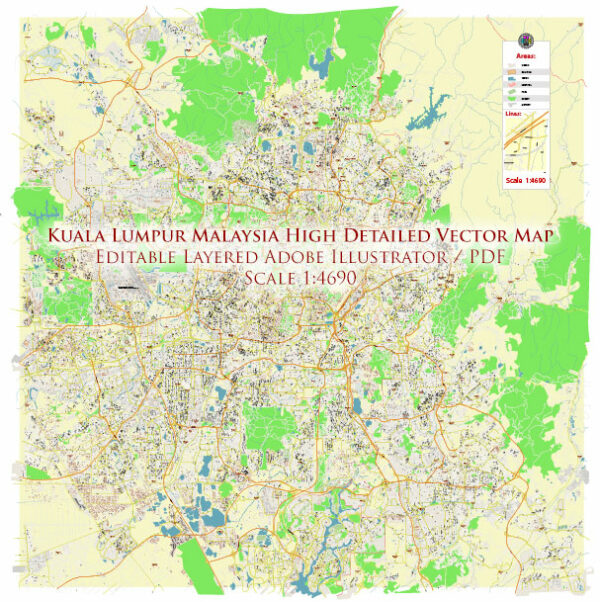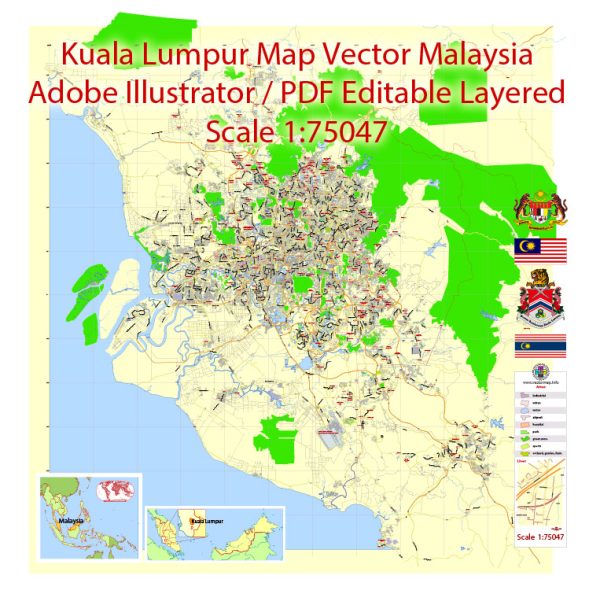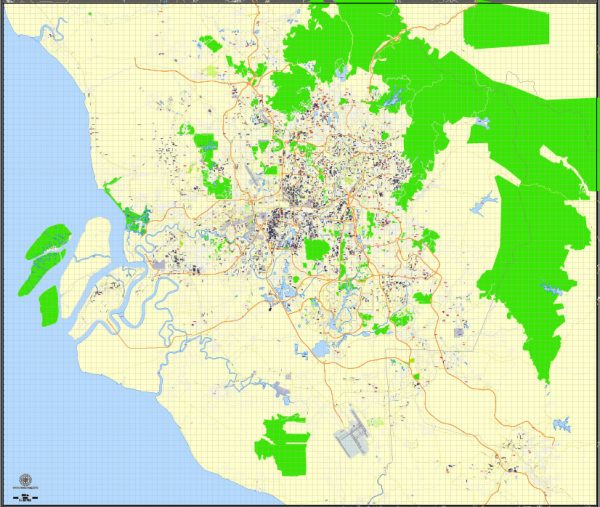Kuala Lumpur, commonly referred to as KL, is the capital city of Malaysia and one of the most dynamic and cosmopolitan metropolises in Southeast Asia. Vectormap.Net provide you with the most accurate and up-to-date vector maps in Adobe Illustrator, PDF and other formats, designed for editing and printing. Please read the vector map descriptions carefully. Here is a detailed overview of Kuala Lumpur:
1. History:
- Kuala Lumpur’s history dates back to the 19th century when it was a small tin mining settlement. It grew rapidly during the British colonial era and gained city status in 1972.
- The city’s name, “Kuala Lumpur,” translates to “muddy confluence” in Malay, reflecting its location at the meeting point of the Klang and Gombak Rivers.
2. Modern Skyline:
- Kuala Lumpur is renowned for its modern skyline, dominated by the iconic Petronas Twin Towers. These twin skyscrapers held the title of the world’s tallest buildings from 1998 to 2004.
3. Cultural Diversity:
- The city is a melting pot of diverse cultures, with a significant population of Malays, Chinese, Indians, and various ethnic groups. This cultural diversity is evident in the architecture, festivals, and cuisine.
4. Architecture:
- KL showcases a blend of architectural styles, from colonial-era buildings in areas like Merdeka Square to modern skyscrapers such as the Petronas Towers and the Kuala Lumpur Tower.
- The Islamic-inspired architecture of the National Mosque and the Moorish design of the Old Kuala Lumpur Railway Station are noteworthy.
5. Shopping and Entertainment:
- Kuala Lumpur is a shopping paradise with a range of shopping malls, markets, and street bazaars. Bukit Bintang is a popular district for shopping, entertainment, and nightlife.
- The city offers a vibrant nightlife scene, with numerous bars, clubs, and entertainment venues.
6. Green Spaces:
- Despite being a bustling urban center, Kuala Lumpur features several green spaces. KLCC Park, Lake Gardens, and Perdana Botanical Garden provide residents and visitors with recreational areas and a break from the city’s hustle.
7. Cuisine:
- Malaysian cuisine, known for its diverse flavors, is well-represented in Kuala Lumpur. From street food stalls to upscale restaurants, the city offers a wide range of culinary experiences, influenced by Malay, Chinese, Indian, and indigenous traditions.
8. Transportation:
- Kuala Lumpur has a well-developed transportation system, including the LRT (Light Rail Transit), MRT (Mass Rapid Transit), monorail, and extensive bus networks. Taxis and ride-sharing services are also widely available.
9. Cultural and Historical Landmarks:
- The city boasts cultural and historical landmarks, such as the National Museum, Sultan Abdul Samad Building, and Thean Hou Temple.
10. Economic Hub:
- Kuala Lumpur is the economic and financial hub of Malaysia, housing the headquarters of many multinational corporations. The city’s economic significance is complemented by its role as a major transportation hub in the region.
Overall, Kuala Lumpur is a dynamic city that seamlessly blends modernity with tradition, offering residents and visitors a rich tapestry of cultural experiences, architectural wonders, and a bustling urban lifestyle.




 Author: Kirill Shrayber, Ph.D.
Author: Kirill Shrayber, Ph.D.